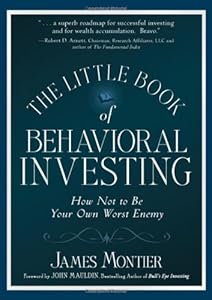“Who’s Afraid of the Big Bad Market?”
I’ve always been afraid of heights. When I heard that a team building session at my last workplace would include a rappelling event, I was scared witless. But I wanted to face my fears and went for it. One look down that 50 foot cliff … and my bravado melted like wax. Sure, I went ahead (in a suicidal kind of mindset) and ended up winning the Comedy Award. I let go of the rope (not supposed to do that) and plastered myself on the cliff wall like a lizard, not going up or down, much to the glee of my supportive teammates.
Next year, we had the session again. And this time I prepared. I had a game plan: “Do not let go of the rope EVER!” After repeating that in my head for about the millionth time, I went ahead and believe it or not, actually made it, if not in the most graceful manner, at least without acute embarrassment.

When I read Chapter 2 of the The Little Book of Behavioral Investing: How not to be your worst enemy, I felt quite proud of myself. After all, I too made a game plan to overcome fear and stuck to it. That’s what the best investors in the world have always done. Stuck to their investment plan, no matter what.
If you remember, author James Montier talked about “empathy gap” and “procrastination” in Chapter 1 – two human frailties that make us bad investors. But the list doesn’t end there. How could it? Turns out we are also susceptible to a strange malady called “temporary paralysis.” Though it’s not a neural disorder in medical terms, it produces similar reactions of helplessness and frustration in investors.
The well-researched causes of temporary paralysis have been found to be “fear” and “brain drain.” To explain, let me (very shortly) give you a gist of various experimental observations recorded by Montier. The first experiment involved a game where higher risks would yield higher returns.
- A group that functions without fear (a state reached after suffering specific brain damage, not caused by a lightning bolt from an alien ship) invests often irrespective of earlier wins or losses. Their profits are optimal.
- People with brain damage but whose X-system is unaffected (hence, can experience fear) invest fewer times and earn lower profits.
- The diffident “normal” group performs the worst. They invest cautiously at all times which drops to less than 40% after suffering a loss. Profits are lowest, well below average.
- As the game proceeds, the decision-making ability of the latter groups only gets worse.
In another experiment involving the Stroop Test, it was found that people with stronger C-systems perform optimally every time. Those with stronger X-systems managed for a while but performance fell steadily thereon. This is “brain drain,” the inability to sustain will power and self-control over an extended period.
So what do these experiments tell us? Fear leads to sub-optimal behavior that only gets worse with time. Montier compares this to how people behave in bear markets. Instead of picking up unbelievable bargains, they hold on to cash out of fear, waiting for the rise from the bottom. They lose the early mover advantage.
Montier’s solution for temporary paralysis is the same “Prepare, plan and pre-commit to a strategy.” Have a battle plan for reinvestment to profit from a tumbling market.
Jeremy Grantham, chief strategist of GMO, suggests investing large sums in a distributed and pre-defined manner instead of taking one giant leap. Seth Klarman, head of Baupost and exemplary value investor advises us to put money to work before it hits bottom. He also warns that things will get worse before they get better. Be ready for it.
Most successful investors, in fact, delink the process of research from buy/sell decisions. Great companies may not always make great stocks and vice versa. The key is to make investment research a continuous process and keep a ready “white-list” of investments that are then traded based on pre-set buy and sell rules.
Bottom line: Plan, pre-commit, and execute. Stay disciplined and block every other thought.
Monica Samuel is doing a chapter-wise review of the book: The Little Book of Behavioral Investing: How not to be your worst enemy by James Montier. You can follow the series by following this tag: tlbbinvesting or by subscribing to this rss feed: tlbbifeed






